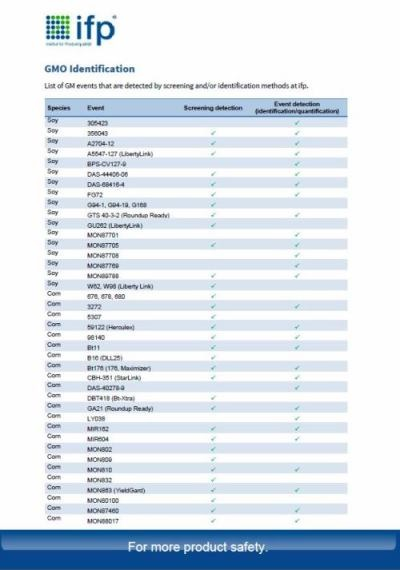GMO Screening
ifp offers a general screening procedure as a first step towards determining genetically modified organisms (GMO) in food and animal feed samples. This screening procedure serves to detect various DNA sequences that are used very frequently in a variety of GMO. General statements about existing GM lines in food and animal feed can therefore be derived from specific combinations of various screening elements. In the event of a negative result, analysis will be complete at this stage.
Molecular biological detection of typical screening elements
For a long time, the 35S promotor and the NOS terminator have been the most relevant regulatory genetic elements in plant biotechnology, which is why analysing these two parameters allowed for a nearly gapless screening of existing GMO. Modern GMO analysis, however, does not solely rely on P-35S and T-NOS anymore when assessing the absence or presence of GMO in a sample. More and more recently approved events contain other regulatory elements instead. Besides various promotors and terminators it is also common to screen for frequently used genes coding for different resistance properties.
ifp Institut für Produktqualität offers the analysis for the following screening elements:
- P-35S: promotor sequence from cauliflower mosaic virus
- T-NOS: terminator sequence of nopaline synthase from soil bacteria Agrobacterium tumefaciens
- bar: phosphinotricin N-acetyl-transferase from Streptomyces hygroscopicus resistance: to the herbicide phosphinotricin (gluphosinat, e.g. LibertyLink and Basta)
- CTP2-CP4EPSPS: intersection of chloroplast-transit peptide to 5-enolpyruvylshikimate-3-phosphate synthase; from Arabidopsis thaliana and Agrobacterium sp. resistence: to herbicide Roundup Ready
- P-35S-pat: intersection of promotor of cauliflower mosaic virus to phosphinotricin-acetyltransferase from Streptomyces viridochromogenes
- nptII: marker gene: neomycin phosphotransferase
- pat: phosphinotricin N-acetyltransferase from Streptomyces viridochromogenes resistance: to the herbicide phosphinotricin (glufosinate, e.g. LibertyLink and Basta)
- P-FMV: promotor from figwort mosaic virus
The ifp Institut für Produktqualität currently has a total of 17 different screening elements.
Quantification of GMO
As a result of regulations (EC) no. 1829/2003 and 1830/2003, the threshold value of 0.9 % relative GMO content necessitates a quantification of the GMO to decide about the declaration of the food. This threshold value is a relative value referring to a particular ingredient in the food. If a food contains an ingredient with 1% soya content, a maximum of 0.9% of this soya content may come from genetically modified soya without triggering a labelling requirement. Addionally, the quantification allows the differentiation of low, unavoidable contaminations occurring during the process of production from larger contaminations with genetically modified organisms.
ifp offers the following parameters:
Soy
- Roundup-Ready-Soy
Corn
- MON810-corn
- Bt176-corn
- Bt11-corn
- TC1507-corn
- T25-corn
- NK 603-corn
- GA21-corn
Canola
- Roundup-Ready-Canola
- LibertyLink-Canola
Genetically Modified Organisms (GMO)
In recent years the cultivation of genetically modified organisms (GMO) has greatly increased. GM crops were cultivated in 28 countries worldwide on 134 million hectares in 2014. ifp offers the detection of genetically modified organisms by real-time PCR. This method allows for highly specific, fast and sensitive detections. Even traces below 0.01 % in a single ingredient can be detected.
For more information on GMO see:
GMO legislation in the EU
In April 2004 regulations (EC) no. 1829/2003 and 1830/2003 entered into force. These regulations stipulate labelling the packaging of GMO in food. In addition, a gap was closed by subjecting animal feed to the approval and labelling regulations as well. Products such as milk and eggs from animals that were fed on genetically modified feed are excluded from the labelling regulations.
The regulation also defined a threshold value of 0.9 %. This threshold value is a relative value referring to a particular ingredient in the food. If a food contains an ingredient containing 1 % soy, for example, a maximum of 0.9 % of this share of soy may originate from genetically modified soy.
GMO analysis from screening to quantification
The typical procedure of GMO analysis comprises the following steps:
- Sample extraction and purification of the DNA samples
- General screening for the existence of GMO
- Identification of the GMO in the samples that had a positive screening result
- Quantification of the identified GMO
The identification and quantification steps are carried out if the result is positive, and after consultation with the client.





